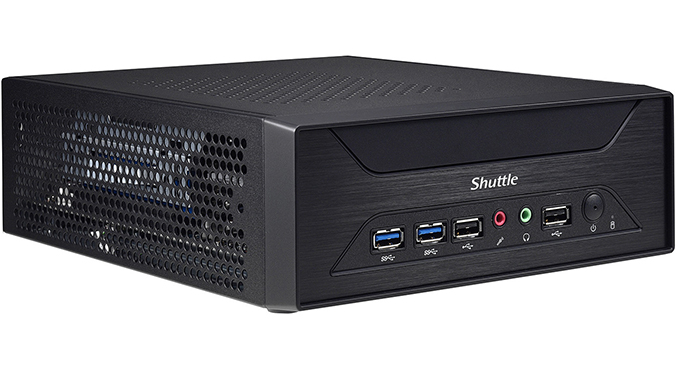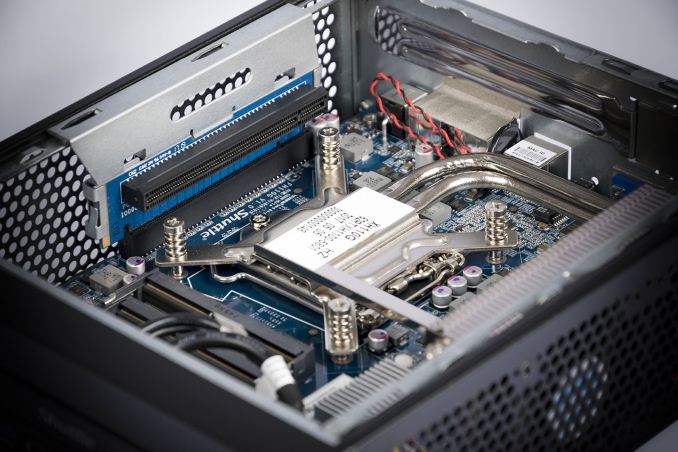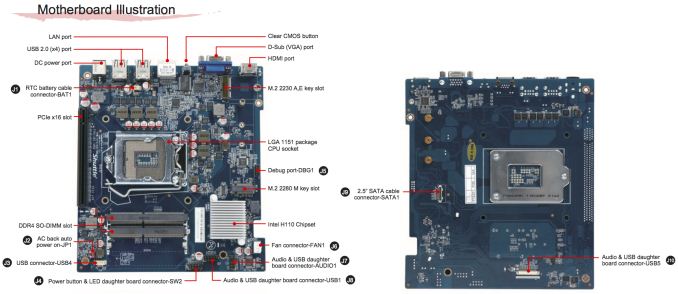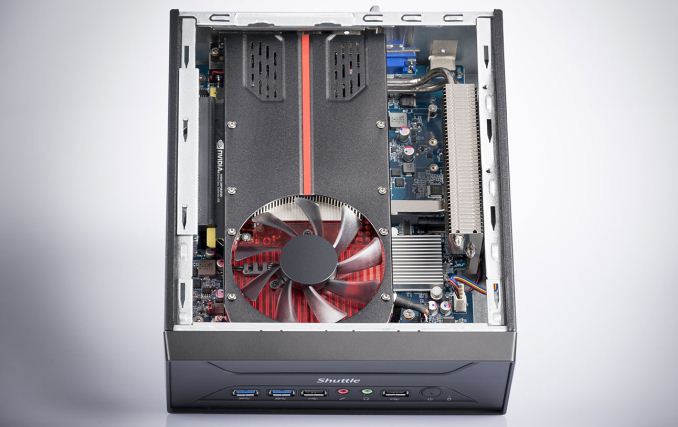Shuttle Squeezes Desktop Graphics Card into a 3-Liter XH110G SFF PC Barebones
by Anton Shilov on August 22, 2017 11:00 AM EST
Shuttle has announced a new small form-factor barebones PC aimed at entry-level gamers as well as those who need a SFF multi-monitor setup, such as graphics professionals, traders, digital signage, control room applications, and so on. The XH110G has a volume of only three liters, but can accommodate a variety of graphics cards, assuming that they do not consume excessive amounts of power and use single-slot cooling systems, because the chassis is only 78.5 mm thick.
The Shuttle XH110G is based on Intel’s H110 PCH and supports all contemporary desktop LGA1151 CPUs that Intel has to offer with up to 65 W TDP (no Xeons, no ECC memory, etc.). Therefore, the fastest processor the XH110G supports is the Core i7-7700, but given the form-factor, it is more likely that owners of the system will choose something like the Core i7-7700T with a 35 W thermal envelope. To cool down its CPU, the XH110G uses a notebook-like ICE cooling system featuring two heat pipes that take away thermal energy from the chip and transfer it to a fairly large radiator located on the right side of the chassis. The radiator is cooled down using two 60-mm fans. Typically, small high-pressure fans have very high RPMs and are noisy. Shuttle does not disclose many details about its fans, but says that the XH110G supports five fan modes for one of the fans: a PWM-controlled smart fan mode along with pre-set ultra-low, low, mid and full speed modes. Meanwhile, the second fan either rotates at a constant speed of around 1300 RPM (based on a screenshot from the BIOS manual - see the gallery below for details) or works at the speed of the first one. For extra ventilation, the XH110G chassis has many holes to ensure sufficient cooling for all components.
When it comes to DRAM and storage, everything looks pretty standard for a modern SFF PC: the XH110G has two SO-DIMM slots supporting up to 32 GB of DDR4-2400 memory, a 2.5” bay for an HDD or SSD located under the motherboard in a special bay, as well as one M.2 slot (PCIe and SATA) located on the motherboard near the fans to ensure proper cooling. Those, who would like to expand storage capacity of the XH110G further can install a USB flash drive into an external USB 2.0 port. Shuttle does not set maximum capacities for SSDs and HDDs supported by the new SFF PC, but since the thickness of the internal USB drive cannot exceed 11.5 mm, it looks like only 7-mm 2.5” storage devices are supported, which means up to 2 TB for contemporary HDDs. Keep in mind that the Intel 110 PCH has 6 PCIe 2.0 lanes, and therefore even if a PCIe 3.0 x4 SSD is used, its maximum throughput will be around 2 GB/s. This may not be a problem for entry-level systems that do not use high-end SSDs, but an advanced solid-state drive will not be a good fit for the XH110G.
Discrete graphics support is clearly a key selling point of the Shuttle XH110G. When it comes to integrated graphics outputs, the system itself has a D-Sub and an HDMI connector, which means that those who want to run two modern monitors will have to get a discrete video card. The graphics board should be installed horizontally above the CPU using a special riser card which has all pins needed for x16 operation. The card should use a single-slot cooler and its maximum length should be no longer than 208.5 mm. Shuttle officially lists AMD’s FirePro W600 and W2100, NVIDIA’s Quadro K2000 and M2000 as well as Matrox’s C680 (this one is particularly important as it can drive six displays) graphics adapters as supported, but the system can handle a great variety of graphics cards. Keep in mind though that the XH110G is powered by a 180 W external PSU and therefore maximum power consumption of a video card should not exceed around 100 W, even with a 35 W CPU. At present, the most powerful graphics adapters that can be installed into the XH110G system are the AMD Radeon RX 460 and NVIDIA’s GeForce GTX 1050 Ti.
As far as connectivity is concerned, the Shuttle XH110G looks rather basic. The system has two USB 3.0 ports on the front, and six USB 2.0 ports in total, a Gigabit Ethernet connector, driven by Intel’s i211 controller, and two 3.5-mm audio jacks. In a bid to get Wi-Fi and Bluetooth, one should buy a separate M.2-2230 WLN-M card from Shuttle (802.11ac, up to 500 Gbps, BT). In addition, the internal USB 2.0 header can be used to plug in a USB accessory, and Shuttle suggests a TV tuner or a 4G/LTE modem.
Rather moderate I/O features of the XH110G are conditioned by the company’s choice of chipset and its intention to keep the price and costs down.
| Shuttle XH110G Specifcations | ||
| Model | SYS-SH-XH110G | |
| CPU | Skylake or Kaby Lake CPU with 35 W or 65 W TDP Up to Intel Core i7-7700 |
|
| dGPU | Single-slot graphics card up to 208.5 mm in length and a sub-100W TDP Up to AMD Radeon RX460 or NVIDIA GeForce GTX 1050 Ti |
|
| DRAM | Two DDR4 SO-DIMM slots Up to 32 GB of DDR4-2400 in dual-channel mode |
|
| Motherboard | Custom | |
| Storage | SSD | M.2-2280 (PCIe 2.0 x4 or SATA) |
| HDD | 2.5"/7mm/9.5 mm SATA 6 Gbps | |
| Wireless | Optional WLN-M 802.11ac Wi-Fi + Bluetooth module | |
| Ethernet | 1 GbE port (Intel i211) | |
| USB | 2×USB 3.0 Type-A 6×USB 2.0 Type-A 1×USB 2.0 internal |
|
| Display Outputs | 1×D-Sub 1×HDMI |
|
| Audio | 2×3.5mm audio jacks (ALC662 controller) | |
| Card Reader | - | |
| PSU | External 180 W PSU | |
| Warranty | Typical, varies by country | |
| Dimensions | Length: 250 mm Width: 200 mm Height: 78.5 mm |
|
| MSRP in Europe | €231 ($319) | |
When it comes to price, the company has succeeded in keeping it low. Shuttle’s XH110G is now available from specialist retailers in Europe for €231 ($319), which is a price of a Mini-ITX case, an Intel B250-based motherboard with integrated 802.11ac Wi-Fi and a circa-400 W PSU. Shuttle’s system looks to be more compact than typical Mini-ITX builds and can be mounted to a display using a VESA mounting mechanism. However, it has a number of peculiarities when it comes to SSD performance, connectivity and support of graphics cards that may not be welcomed by enthusiasts.
Related Reading:
- Shuttle’s X1 Now Available: NUC-Like PC With a GeForce GTX 1060 GPU
- Corsair’s ONE SFF PCs Get Upgraded: GeForce GTX 1080 Ti, 32 GB of RAM, NVMe SSD
- Zotac Unveils 2017 ZBox Magnus SFF Gaming PCs: Powered By Intel Core & AMD Ryzen
- ASUS VivoPC X Console Now Available: Core i5, GeForce GTX 1060 for $799
- MSI Upgrades Its Aegis and Nightblade PCs with Intel’s Kaby Lake CPUs
- MSI Trident 3 Announced: A Core i7 Console
Sources of information and images: TechPowerUp, Shuttle.



















22 Comments
View All Comments
fackamato - Tuesday, August 22, 2017 - link
Great point. I'm looking at ITX cases now. Thanks!mm0zct - Friday, August 25, 2017 - link
You can probably get better these days, especially if you're happy to do without an optical drive, but I'm using a Lian-Li PC Q08 www.lian-li.com/en/dt_portfolio/pc-q08. This will fit pretty much any dual-slot card, I'm using it with an Nvidia 1060, previously I had an AMD 7870 in it, but there's space for larger cards still.Samus - Wednesday, August 23, 2017 - link
Yeah, it's definitely pushing the limit of the PSU.Bullwinkle J Moose - Tuesday, August 22, 2017 - link
Where can I get the reverse of that hard riser card?I may need to go with a ribbon if I can't find the right card
I was looking for a low profile riser that mounts the graphics card on the opposite side so I can squeeze a mini ITX into a 1U (1.75" Tall X 19" wide) case with rubber feet so I can intake fresh air from the bottom directly into the graphics card
May need to go to 1.5U if cpu cooling is a problem but the width is perfect for setting my monitor on top of the PC and I need a bit more height for the monitor anyway
----------------------------------------------------------------------------
|||||| Graphics card ||||||---[__________CPU___________]
[[[[[[[[[[------------------------------------------------------------]]]]]]]]]]
JoeyJoJo123 - Tuesday, August 22, 2017 - link
I imagine you're looking for an internal riser cable, because to fabricate the exact riser card you're looking for would require manufacturing of a custom PCB to match your case's dimensions. If your 1U case didn't come with a riser card and the manufacturer doesn't sell a riser card, it's better to stick with a flexible riser cable since you can just fold away excess cable while managing your cables..This is one such example, but there are alternatives on the market:
https://www.newegg.com/Product/Product.aspx?Item=N...
You're most likely better served by using a chassis that actually has the internal riser card included in the purchase. The Node 202, ML07B, FTZ01B, and RVZ02B all include rigid riser cards (as opposed to cables) manufactured especially for the case, but if your intention is to rack mount it (you mention RU), then you can either get a 2U shelf or attempt to find a server chassis that supports rackmounting and has an included riser card for GPUs.
I imagine the chassis I've listed won't work since they're thicker than 1U and since you mention rack mounting, you're probably pretty limited on options given available rack space.
guidryp - Tuesday, August 22, 2017 - link
So often any of the small solutions are double the price. This is actually quite reasonable.Lolimaster - Tuesday, August 22, 2017 - link
They need to ditch using obsolets cpu's like the intel's.They could easily opt for the Ryzen 7 1700, with a minor tweak in a custom bios they can get the power consumption down to <45w @3Ghz and get updates all the way to 2020, 1151 is a dead platform.
Gunbuster - Tuesday, August 22, 2017 - link
Just shuttle reminding us they currently have the worst industrial designers in the industry, I swear they had more modern looking products in 2001...Calista - Thursday, August 24, 2017 - link
It was the very first think to struck my mind as well. But this seems geared towards business use, so maybe those multi coloured audio ports can be excused.But sometimes the computer industry seem to really act backwards. Tweak this offering a bit and it would be a very enticing product for light gamers. Instead of an external powerbrick use an internal. How hard can it possibly be to cool down a maximum of ~15 watt of excessive heat from a PSU? Remove that silly VGA connector and add more USB3-ports. And make room for a double-height graphic card since this would allow the use of a GTX 1050Ti without breaking a ~160 watt total power draw celling.
Twingo - Wednesday, August 23, 2017 - link
This only accepts single slot cards. I don't think a single slot 1050 Ti exists does it?Think AT needs to do a little more background on this as I can't find a 1050 Ti single slot so don't claim this can support one. The 1030 looks like the limit to me.